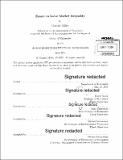Essays on labor market inequality
Author(s)
Miller, Conrad, Ph. D. Massachusetts Institute of Technology
DownloadFull printable version (11.97Mb)
Alternative title
Essays in labor economics
Other Contributors
Massachusetts Institute of Technology. Department of Economics.
Advisor
David Autor, Amy Finkelstein, and Michael Greenstone.
Terms of use
Metadata
Show full item recordAbstract
This thesis consists of three chapters on aspects of labor market inequality. In chapter 1, I estimate the dynamic effects of federal affirmative action regulation, exploiting variation in the timing of regulation and deregulation across work establishments. I find that affirmative action sharply increases the black share of employees, with the share continuing to increase over time: five years after an establishment is first regulated, its black share of employees increased by an average of 0.8 percentage points. Strikingly, the black share continues to grow even after an establishment is deregulated. Building on the canonical Phelps (1972) model of statistical discrimination, I argue that this persistence is in part driven by affirmative action inducing employers to increase the precision with which they screen potential employees. I then provide supporting evidence. In chapter 2, I study the spatial mismatch hypothesis, which proposes that job suburbanization isolates blacks from work opportunities and depresses black employment. Using synthetic panel methods and variation across metropolitan areas from 1970 to 2000, I find that for every 10% decline in the fraction of metropolitan area jobs located in the central city, black employment (earnings) declined by 1.4-2.1% (1.1-2.3%) relative to white employment (earnings). This relationship is driven primarily by job suburbanization that occurred during the 1970's. To address the potential endogeneity of suburbanization, I exploit exogenous variation in highway construction and find that highways cause job suburbanization and declines in black relative employment in a manner consistent with spatial mismatch. In chapter 3, joint work with Isaiah Andrews, we analyze the effect of heterogeneity on the widely used analyses of Baily (1978) and Chetty (2006) for optimal social insurance. The basic Baily-Chetty formula is robust to heterogeneity along many dimensions but requires that risk aversion be homogeneous. We extend the Baily-Chetty framework to allow for arbitrary heterogeneity across agents, particularly in risk preferences. We find that heterogeneity in risk aversion affects welfare analysis through the covariance of risk aversion and consumption drops, which measures the extent to which larger risks are borne by more risk tolerant workers. Calibrations suggest that this covariance effect may be large.
Description
Thesis: Ph. D., Massachusetts Institute of Technology, Department of Economics, 2014. Title as it appears in MIT commencement exercises program, June 6, 2014: Essays in labor economics Cataloged from PDF version of thesis. Includes bibliographical references (pages 135-141).
Date issued
2014Department
Massachusetts Institute of Technology. Department of EconomicsPublisher
Massachusetts Institute of Technology
Keywords
Economics.